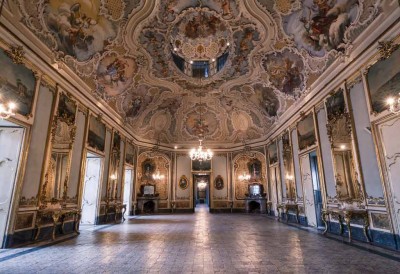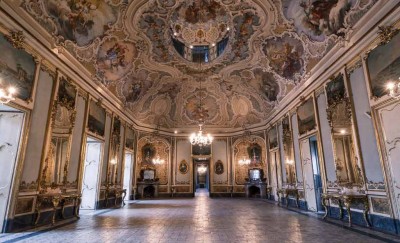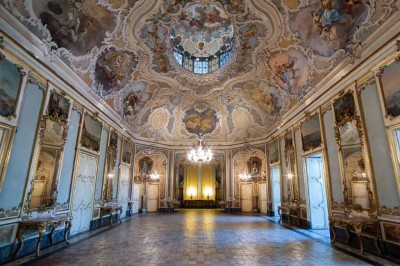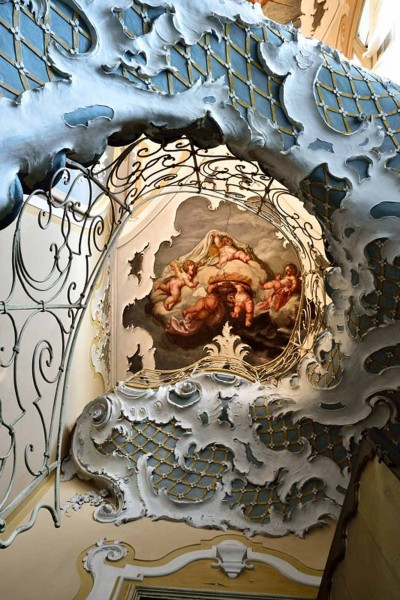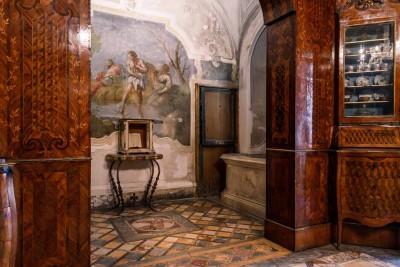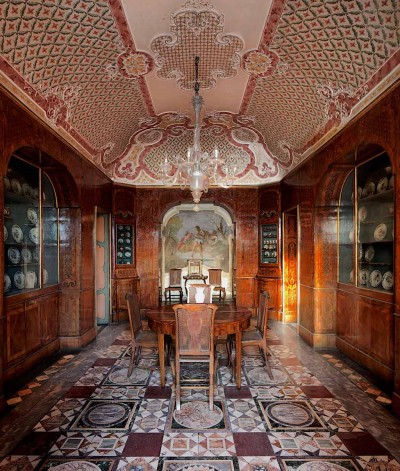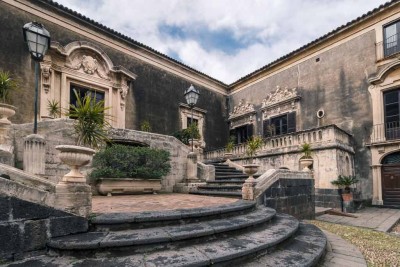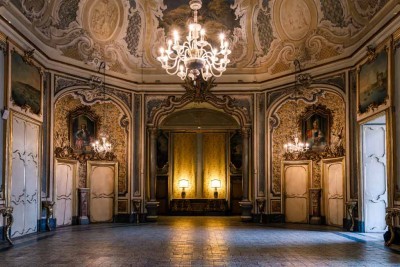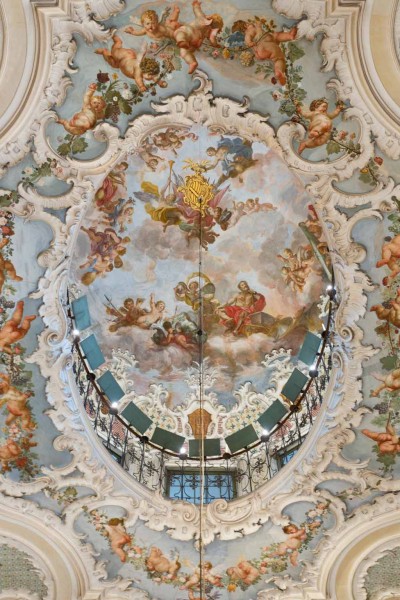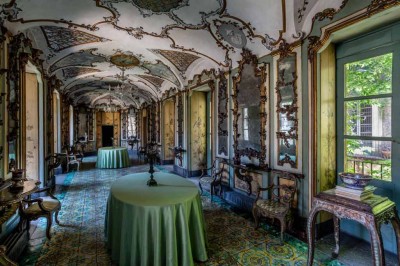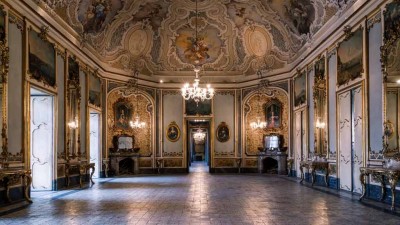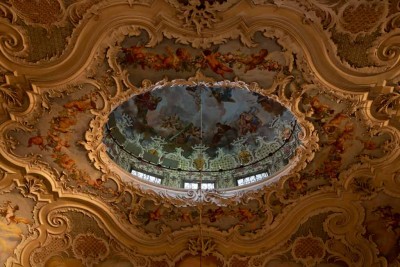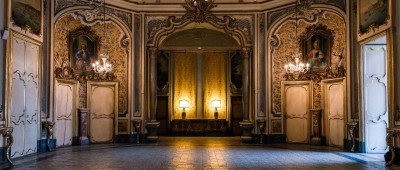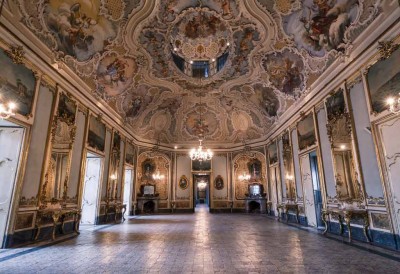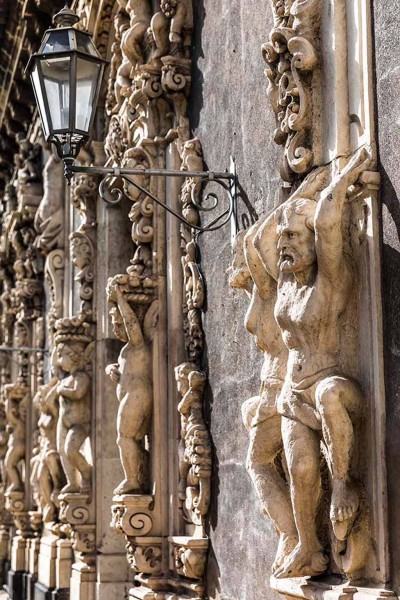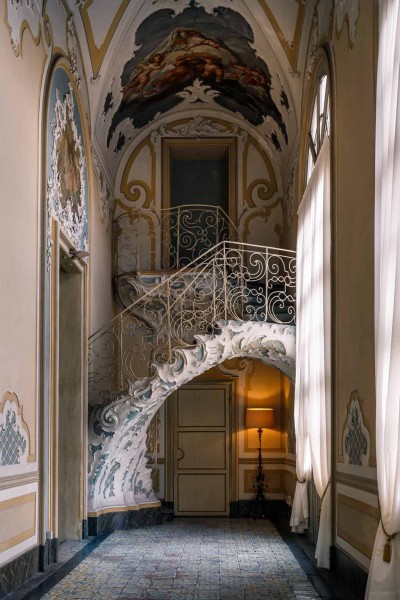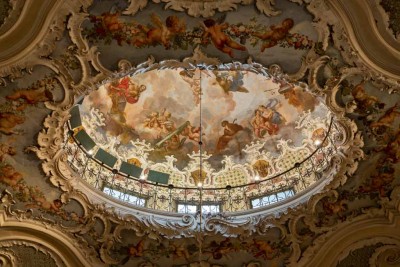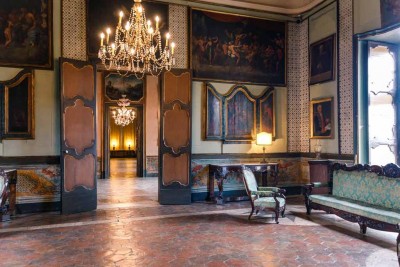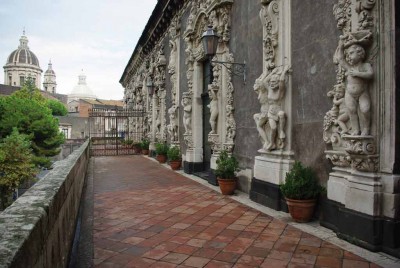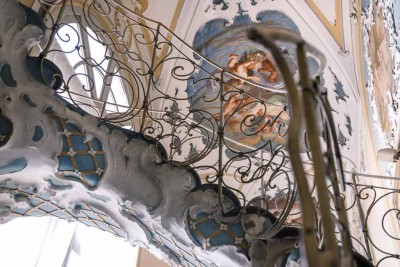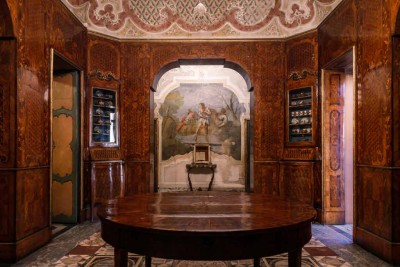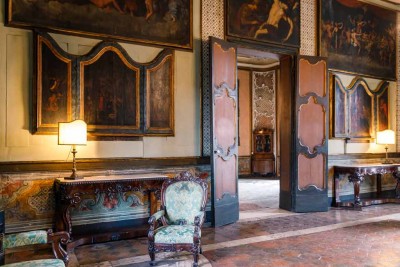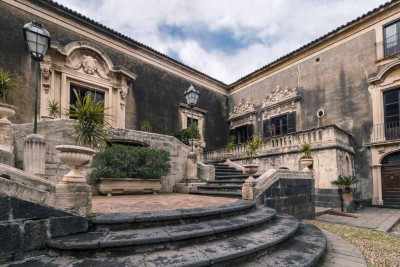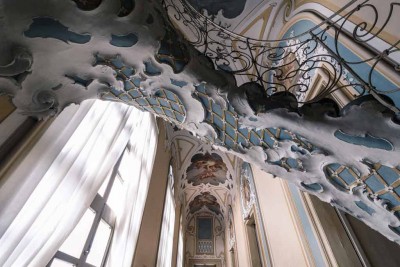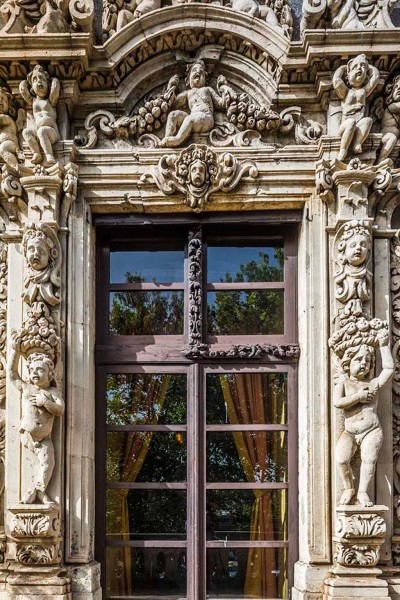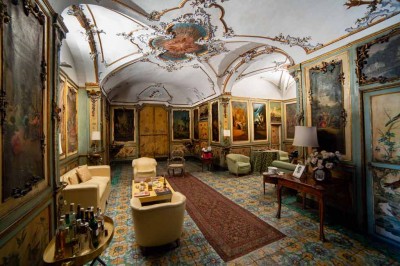Contact the abode
PALAZZO BISCARI, A TRIUMPH OF SICILIAN BAROQUE STYLE IN CATANIA
Abundance, Prosperity, Fertility and Wisdom are the four themes depicted in the allegorical groups of decorations on Palazzo Biscari's exterior and most opulent façade facing the sea. First built in 1707, it stands on the sixteenth-century walls erected by Charles V and serves as the gateway to the city for those arriving from the sea. The view is nothing short of remarkable: the balconies and pilasters in white Syracuse stone emerge from the black lava base, adorned with flowers, cherubs, fauns and telamon sculptures. The rear facade, facing the marina, consists of seven enormous stained-glass windows containing extraordinarily crafted sculptures and decorations in the Sicilian Baroque style, which is so opulent that the entrance façade seems plain by contrast!
The front façade on Via Museo Biscari lacks any prominent features, with the exception of its grand portal, which is the largest and most ornate of its kind in Catania. Authorised for construction in the early 1700s, it bears the genealogical banner of Prince Vincenzo IV. Visitors access the vast courtyard through this entrance, once filled with trees, flowerbeds and pergolas, but unfortunately now bare. The courtyard leads to a majestic dog-legged staircase that ascends to the grand hall housing numerous paintings representing the Biscari family's feudal possessions. From there, one enters the Green Room, adorned with paintings and overdoor artworks, featuring a beautiful floor made of terracotta inlaid with white Syracuse stone.
THE ORCHESTRAL BALLROOM
The Red Room next door contains portraits of eminent members of the Biscari household. This room leads into the spacious Hall cum Ballroom known as the ‘Salone dell'Orchestra’, a magnificent example of Rococo architecture with Neapolitan influences. The walls are adorned with large overdoor paintings depicting views of the capital of the Kingdom, Naples, the Gulf, Vesuvius and the surrounding area. The fresco on the ceiling, representing the Council of the Gods, celebrates the Biscari family's glory. Its vault is particularly noteworthy due to the fact that its ceiling opens up to a sizeable balcony at its peak, which follows the oval shape of the Salon and is enclosed by a railing. The dome, which completes the grand vault of the Salone, was where the musicians would perform, barely visible to those below. It is accessed via a stucco-decorated staircase, which Prince Ignazio described as cloud-like ("a fiocco di nuvola"), inside the spacious gallery overlooking the marina. In addition to the mirrors covering the entire walls, white doors and gleaming Neapolitan ceramic floor, one can also observe the large individual mirrors positioned above the fireplaces in the niches, reflecting the light and by association thereby symbolically evoking fire, in keeping with the allusive world of the Rococo style. The god of fire, Vulcan, can also be detected in the fresco on the ceiling.
THE PRIVATE APARTMENTS
Adjacent to the salons is a small suite, where the Biscari family reside in their private apartments. It contains a room lined with rosewood panelling and flooring designed using the ‘commesso’ technique, obtained by tastefully assembling fragments of Roman marble. Boiserie wood panels, inlays, mirrors, frescoes, porcelain and chinoiserie decorations can be found in the apartment rooms on the first floor, notably in the Bird Gallery and the ‘Don Quixote’ Room. The former, which is adorned with mirrors and embellished with numerous small diaphanous porcelains, has an exquisite ceramic floor. The panels and doors all showcase a variety of bird species, accompanied by ornamental scroll inscriptions providing their names. On the walls of the Don Quixote Room are paintings illustrating the hidalgo’s many exploits, inspired by engravings drawn by Charles-Antoine Coypel, chief painter to the King of France.
ARCHITECTS AND ARTISTS
The architects called upon to construct Palazzo Biscari were Alonzo Di Benedetto, who was responsible for the oldest part, while Girolamo Palazzotto and Francesco and Antonino Battaglia completed the eastward extension and the museum spaces. Among the artists involved were Messina sculptor Antonino Amato, who decorated the seven splendid windows overlooking the marina, and Giovanbattista Piparo, who painted some of the frescoes. The mirrors, stuccos, and other frescoes, meanwhile, were the work of Matteo Desiderato. The overdoor paintings in the Orchestral Hall were painted by Eustachio Pesci and the fresco on the ceiling was by Sebastiano Lo Monaco.
THE HISTORY OF PALAZZO BISCARI
Together with the Monastery of San Nicolò l'Arena, Palazzo Biscari, the residence of the Paternò Castello family, Princes of Biscari, is the most important and well-known example of 18th-century architecture in Catania. It stands on a section of the city's sixteenth-century walls, on which, immediately after the earthquake of 1693, Ignazio Paternò Castello III, Prince of Biscari (d. 1699), obtained permission to build the Palazzo from Lieutenant General Giuseppe Lanza, Duke of Camastra, who oversaw Catania's reconstruction on behalf of King Charles II of Spain. It was his son, Vincenzo IV, Prince of Biscari (1685-1749), who then continued the work, and his grandson, Ignazio V (1714-1786), duly completed it. A great scholar, archaeologist and lover of the arts in general, Ignazio V played a prominent role in Catania's cultural life in the mid-eighteenth century and dedicated ample spaces in the Palazzo to the establishment of an archaeological, numismatic and natural history museum which would be accessible to all scholars.
THE COLLECTIONS BELONGING TO THE PRINCES OF BISCARI
The large rooms adorned with columns, arranged around two courtyards, contained valuable collections of coins, medals, engraved gemstones, ancient cameos, drawings, prints and pieces of armoury, which were mentioned and eulogised in the diaries of the many scholars from all over Europe who came to visit the Palazzo in the 18th century. Goethe is perhaps the most famous, but already fifty years before him eminent visitors came to see the collections from Denmark, Russia, Germany, Poland, Spain, France and England, as well as all the Italian states, including the Kingdom of Sardinia, the Grand Duchy of Tuscany and the Church States. A significant portion of the collections housed in the Prince of Biscari Museum in the 1930s was donated to the Municipality of Catania and transferred to the Civic Museum of Castello Ursino, where they are still partially exhibited today.
THE CURRENT OWNERS
Palazzo Biscari is still largely inhabited by the descendants of the family, and its main reception rooms are often used for prestigious social and cultural events. Exhibitions, conferences, conventions and concerts have been hosted here since 1971.
EVENTS AT PALAZZO BISCARI
Palazzo Biscari is one of Catania's oldest historical residences and is a precious testament to the Sicilian Baroque style. Its frescoed halls, rich in charm and elegance, serve as a splendid venue for important occasions such as concerts, meetings, receptions, gala evenings, fashion shows and other types of event. Located close to the Cathedral, Via Crociferi, Teatro Bellini, Piazza Università, Palazzo degli Elefanti, Via Etnea and Castello Ursino, it is just six kilometres from Fontanarossa International Airport and is only a few minutes away from the central railway station.
CONCERTS
The halls of Palazzo Biscari are an ideal location for holding concerts and cultural activities. Over the past decades, more than 300 concerts and major musical festivals have been organised here.
CONFERENCES
Palazzo Biscari is an elegant and technologically well-equipped venue suitable for hosting meetings and conferences of all kinds, as it is both private and has a very suggestive backdrop. One of its main advantages as a setting for corporate events is its excellent accessibility.
RECEPTIONS AND CEREMONIES
From small luncheons in the central hall to working brunches in the lounges during meetings and receptions and to gala dinners for up to 350 people: the evocative beauty of the architecture and the intimate atmosphere of some of the smaller spaces make it an ideal location for civil and symbolic weddings.
EXHIBITIONS
Palazzo Biscari has a long tradition connected to art and temporary exhibitions, dating back to its construction. More recently, it has also hosted innovative and site-specific exhibitions by well-known international artists.
FILM LOCATION
The beauty of its salons, Baroque terraces and imposing courtyard have collectively made Palazzo Biscari a captivating location for film sets, music videos and advertising commercials.
FASHION SHOWS
The elegant spaces and supporting services make Palazzo Biscari an ideal location for organising fashion shows, presentations of clothing collections and jewellery exhibitions.
MUSIC RECORDINGS
The magnificent acoustics of the main hall, which is receptive to all every type of music played, be they string, plucked or blown, woodwind, brass, or wooden instruments, lends itself as an ideal venue for recording ancient and baroque chamber music, small operas or light-hearted plays and dramas.
CAPACITY
Receptions: up to 350 people
Conferences: up to 200 people
Guided tours of the private apartments: up to a maximum of 20 people at a time
SALONS/ROOMS
Green Room Gallery: 70 people
Red Room: 70 people
Orchestral Hall: 200 people
ADDITIONAL SERVICES
Exhibition area, cloakroom, hostesses and stewards, interpreters, reception, catering service, high speed ADSL internet connection, amplification sound system, overhead projectors, video projectors, projection screens, radio microphones.
Palazzo Biscari can also provide, on request, specific services for organization and setup, technical or logistical assistance, video-photographic services and floral decorations for the events.
VISITING PALAZZO BISCARI
It is possible to reserve a visit of Palazzo Biscari and take a guided tour that retraces the history of the Palazzo, the Baroque masterpieces and noble life in Catania during the 18th and 19th centuries. The visit focuses on artistic and architectural details and narrates the vicissitudes of the main characters who have inhabited the Palazzo. For bookings for particularly large groups and for all further information, requests and requirements, please write or call the following contacts:
Website: https://www.palazzobiscari.it/it/visite-guidate/
Email: visite@palazzobiscari.it
Telephone: +39 095 328 72 01
PRICES
Prices for the visit: please consult the website www.palazzobiscari.it/it/visite-guidate/
Duration: please consult the website www.palazzobiscari.it/it/visite-guidate/
Meeting Point: main entrance of the Palazzo
Languages: French, English, Italian
Children: allowed
Pets: allowed
Disabled access: available upon request at the time of booking.
PLACES OF INTEREST IN THE VICINITY
- Archaeological Area of Agrigento
- Roman Villa of Casale, Piazza Armerina
- Late Baroque Towns of the Val di Noto (Militello in Val di Catania, Palazzolo Acreide, Caltagirone, Catania, Modica, Noto, Ragusa, Scicli)
- Syracuse and the Rock Necropolis of Pantalica
- Mount Etna
- The Aeolian Islands
